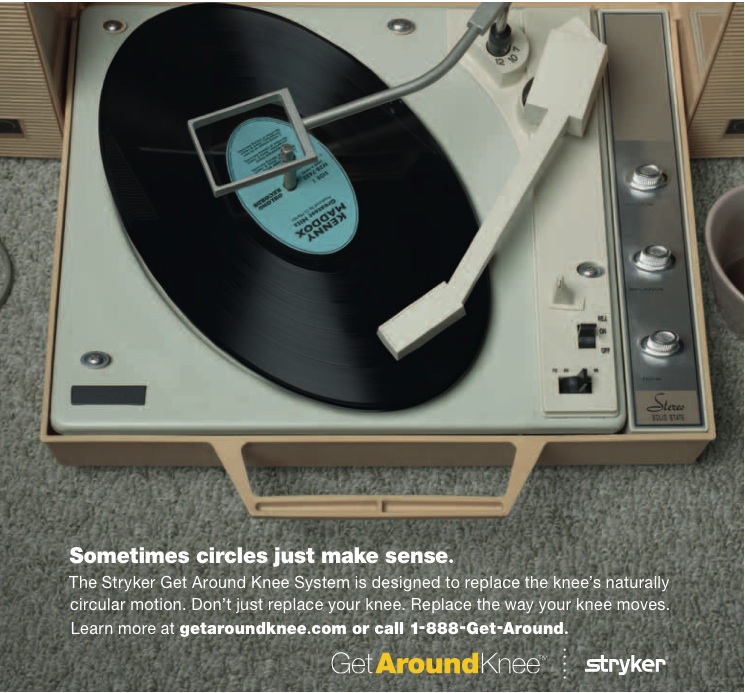Thirty-three percent of visitors to Stryker’s branded website GetAroundKnee.com are heading straight for the surgeon locator, Paul Berman, the firm’s VP of global knee marketing told MM&M. The high search rate, which Berman described as “a fairly large chunk of traffic,” is much higher than it had been before rolling out the still-nascent campaign for its roughly eight-year-old orthopedic device, known in the trade as the Triathalon knee. (Stryker also sells a similar product called the Scorpio outside of the US).
The spike in web traffic is a direct result of the company’s first television campaign since its 2003 campaign for ceramic hips that featured golfer Jack Nicklaus. Berman said the re-branding’s objective was to help patients appreciate the advantage of its artificial knee, which is round, in an effort to mimic the knee’s naturally circular motion. Most of the replacements on the market are oval, and Stryker sought to make this distinction a focal point. DTC ads by inVentiv Health’s GSW Worldwide show a vintage turntable spinning an oval-shaped record and a woman riding a bike with oval wheels.
Hence the new product name, the Get Around Knee System, which Berman said was chosen because it’s “easy to remember, a bit catchy and really connected to the benefit of the product.” The ability to articulate the round vs. oval difference, both with the name and through an online animation, was an opportunity the company had overlooked until it saw market research data showing that this comparison was critical among test subjects. “It was amazing to see how excited [focus groups] got with that simple difference and how motivating it was,” he said.
The 2012 re-branding and promotion kicked off first with a communications stream to orthopedic surgeons in January to tell them about the influx of patient-education materials. Then the patient-oriented materials were sent into the marketplace in May. Berman said the two-step strategy was an important tactic, both because the company “wanted to avoid something it had seen competitors do, which is to approach patients without educating the medical people,” and because it was a safety net of sorts that allowed the company to field professional input before putting information into the hands of patients that could inspire ire among the surgeons.
The professional input resulted in a few tweaks, such as changing the types of patient activities shown in ads, and bolstering claims with more clinical information. This new information became part of the May rollout, which started with print ads in Time and People. The campaign then progressed to include three 30-second TV ads which appear during early morning and evening news hours on stations including CNN, FoxNews and TNT.
Although the print ads were used to introduce patients to the product, Berman said TV is the more critical media plan component; their market research showed that Baby Boomers — prime candidates for knee replacement — logged in around 29 hours of TV a week. Berman said the figure was much higher than Stryker expected, and the campaign dollars are following the eyeballs, which means TV beats out digital and digital beats out print.
Berman said Stryker’s move to evocative, patient-friendly marketing was prompted by an overall power shift in the medical landscape. “Patients continue to play a more active role in selecting brands of orthopedic devices,” he said.
This insight led to a campaign that told the knee’s story in an easy, understandable way that included animations which emphasize the knee’s round track, and which has become one of the most visited parts of the campaign website.
The patient campaign is still in its early days, so the company is not yet able to translate web hits to surgical bookings, yet Berman said early indicators — web hits, phone calls and use of the surgeon locator — “are all higher than our expectations.” He credits the two-step rollout as a key part of the early success.
Berman noted that the company expects a lag time of between six and 12 months between the campaign launch and inventory moves. That said, interest patterns are tracking with, if not ahead of the market research, and he said the company is looking into expanding the Get Around Knee narrative to include its ShapeMatching system, which is used to customize the prosthetic. What’s more, PGA golfer Fred Funk, who is also part of the Get Around Knee promotion, may be used for local promotion efforts.
Early successes have “definitely got us thinking about how else we could leverage this message,” said Berman, for other parts of the business, including hips and other Stryker products.







